In Situ-Prepared Nanocomposite for Water Management in High-Temperature Reservoirs
Abstract
1. Introduction
2. Results and Discussion
2.1. Gelation Performance
2.2. Surface Modification
2.3. Enhancement Properties and Mechanisms
2.4. Application Performance
2.4.1. Aging Resistance
2.4.2. Practical Application
2.4.3. Gel Degradation
3. Conclusions
- (1)
- Gelation Performance Enhancement: Silica sol extended the gelation time to 72 h while significantly improving gel strength, attributed to the structured assemblies integrate into the polymer chain clusters and meshes. Both storage and loss modulus increased compared to silica-free gels, confirming mechanical reinforcement via hybrid organic–inorganic networks.
- (2)
- Thermal Stability and Water Retention: Bound water content rose from 22% (SS-free) to 36% in SS-modified gels, correlating with hydroxyl-mediated hydration layers on nanoparticle surfaces. The maximum tolerable temperature rose from 114 °C (0% SS) to 156 °C (6% SS), owing to stabilized water–polymer interactions and restricted chain mobility.
- (3)
- Strengthening Mechanism: A three-dimensional network architecture was observed, where silica aggregates form an interfacial interaction with polymer bundles, mechanically reinforcing the gel matrix. The synergistic interplay of hydrogen-bonded hydration layers and electrostatic interactions elevates the bound-water ratio, correlating with stronger hydrophilicity, superior water retention, and enhanced thermal resistance.
- (4)
- Field-Relevant Performance: The core permeability reduction of 92.4% post-gelation demonstrates effective pore throat sealing, critical for water management in fractured reservoirs. The synergistic network design enables controlled decomposition without secondary contamination, addressing environmental concerns in oilfield applications.
- (1)
- Further exploration of the hydrogel’s properties under different dehydration conditions to better understand the correlation between structural dehydration and network damage.
- (2)
- Investigation of ways to enhance the hydrogel’s stability and reversibility under varying environmental conditions.
- (3)
- Exploration of hydrogels’ potential applications in specific fields to validate their practical utility.
4. Materials and Methods
4.1. Materials
4.2. Method for Gel Preparation and Gel Degradation
4.2.1. Gel Preparation
4.2.2. Gel Degradation
4.3. Characterization
4.3.1. Measurement of the Gelation Time (GT) and Strength (GS)
4.3.2. Viscosity and Rheology Measurements
4.3.3. Scanning Electron Microscopy (SEM) Scanning
4.3.4. Calculation Methods
4.3.5. Differential Scanning Calorimetry (DSC) Measurement
4.3.6. Quartz Crystal Microbalance with Dissipation (QCM-D) Measurement
4.3.7. Contact Angle (CA) Measurement
4.3.8. Injectivity and Temporary Plugging Performance Evaluation
- (1)
- Initial water flooding: Brine solution was injected at 0.5 mL/min and 90 °C, with intermediate container 3 open and container 4 closed. Injection rates and nodal pressures (front/middle sections) were recorded until pressure stabilization.
- (2)
- Gel precursor injection: Container 3 was closed, and container 4 was opened to inject the gel precursor solution. Nodal pressures were monitored to assess flow resistance during precursor delivery.
- (3)
- Post-flooding evaluation: Brine solution was reinjected to measure residual injectivity, with pressure data collected until equilibrium.
4.3.9. Plugging Performance Evaluation
- (1)
- Baseline brine flooding: The brine-saturated core underwent brine injection (container 3 open, container 4 closed) until stable nodal pressures were achieved.
- (2)
- Gel formation: The gel precursor was injected, followed by a 3-day aging period to enable in situ cross-linking.
- (3)
- Post-treatment evaluation: Water flooding resumed until pressure stabilization, and the plugging rate (%) was calculated using the following equation [42]:
Supplementary Materials
Author Contributions
Funding
Institutional Review Board Statement
Informed Consent Statement
Data Availability Statement
Conflicts of Interest
References
- Sydansk, R.D.; Southwell, G.P. More Than 12 Years of Experience with a Successful Conformance-Control Polymer Gel Technology. SPE Prod. Facil. 2000, 15, 270–278. [Google Scholar] [CrossRef]
- Zhu, D.Y.; Hou, J.R.; Chen, Y.G.; Wei, Q.; Zhao, S.D.; Bai, B.O.J. Evaluation of Terpolymer-Gel Systems Crosslinked by Polyethylenimine for Conformance Improvement in High-Temperature Reservoirs. SPE J. 2019, 24, 1726–1740. [Google Scholar] [CrossRef]
- Wang, W.; Liu, Y.Z.; Gu, Y.G. Application of a Novel Polymer System in Chemical Enhanced Oil Recovery (EOR). Colloid Polym. Sci. 2003, 281, 1046–1054. [Google Scholar] [CrossRef]
- Liu, Y.F.; Dai, C.L.; Wang, K.; Zhao, M.W.; Gao, M.W.; Yang, Z.; Fang, J.C.; Wu, Y.N. Investigation on Preparation and Profile Control Mechanisms of the Dispersed Particle Gels (DPG) Formed from Phenol Formaldehyde Cross-linked Polymer Gel. Ind. Eng. Chem. Res. 2016, 55, 6284–6292. [Google Scholar] [CrossRef]
- Sang, Q.; Li, Y.J.; Yu, L.; Li, Z.Q.; Dong, M.Z. Enhanced Oil Recovery by Branched-Preformed Particle Gel Injection in Parallel-Sandpack Models. Fuel 2014, 136, 295–306. [Google Scholar] [CrossRef]
- Liu, Y.F.; Dai, C.L.; Wang, K.; Zou, C.W.; Gao, M.W.; Fang, Y.C.; Zhao, M.W.; Wu, Y.N.; You, Q. Study on a Novel Cross-Linked Polymer Gel Strengthened with Silica Nanoparticles. Energy Fuels 2017, 31, 9152–9161. [Google Scholar] [CrossRef]
- Liu, J.; Seright, R.S. Rheology of Gels Used for Conformance Control in Fractures. SPE J. 2001, 6, 120–125. [Google Scholar] [CrossRef]
- Bai, B.; Zhou, J.; Yin, M. A Comprehensive Review of Polyacrylamide Polymer Gels for Conformance Control. Pet. Explor. Dev. 2015, 42, 525–532. [Google Scholar] [CrossRef]
- Hutchins, R.D.; Dovan, H.T.; Sandiford, B.B. Field Applications of High Temperature Organic Gels for Water Control. In Proceedings of the SPE/DOE Improved Oil Recovery Symposium, Tulsa, Oklahoma, 21–24 April 1996. [Google Scholar]
- Hu, Z.; Lu, X.; Gao, J.; Wang, C. Polymer Gel Nanoparticle Networks. Adv. Mater. 2000, 12, 1173–1176. [Google Scholar] [CrossRef]
- Liu, Y.; Zhu, M.F.; Liu, X.L.; Zhang, W.; Sun, B.; Chen, Y.M.; Adler, H.J.P. High Clay Content Nanocomposite Hydrogels with Surprising Mechanical Strength and Interesting Deswelling Kinetics. Polymer 2006, 47, 1–5. [Google Scholar] [CrossRef]
- Aalaie, J.; Vasheghani-Farahani, E.; Rahmatpour, A.; Semsarzadeh, M.A. Effect of Montmorillonite on Gelation and Swelling Behavior of Sulfonated Polyacrylamide Nanocomposite Hydrogels in Electrolyte Solutions. Eur. Polym. J. 2008, 44, 2024–2031. [Google Scholar] [CrossRef]
- Bai, Y.; Xiong, C.; Wei, F.; Li, J.; Shu, Y.; Liu, D. Gelation Study on a Hydrophobically Associating Polymer/Polyethylenimine Gel System for Water Shut-off Treatment. Energy Fuels 2015, 29, 447–458. [Google Scholar] [CrossRef]
- He, H.; Wang, Y.; Sun, X.; Zhang, P.; Li, D. Development and Evaluation of Organic/Inorganic Combined Gel for Conformance Control in High Temperature and High Salinity Reservoirs. J. Pet. Explor. Prod. Technol. 2015, 5, 211–217. [Google Scholar] [CrossRef]
- Yang, H.; Li, L.; Dong, G.; Wei, Q.; Zhang, J.; Wang, X.; Wang, Z.; Xu, C.; Zhang, Z. High-Temperature-Resistant and Gelation-Controllable Silica-Based Gel for Water Management. Energy Fuels 2024, 38, 23398–23406. [Google Scholar] [CrossRef]
- Lakatos, I.J.; Lakatos-Szabo, J.; Szentes, G.; Vago, A.; Bodi, T. New Alternatives in Conformance Control: Nanosilica and Liquid Polymer Aided Silicate Technology. In Proceedings of the SPE European Formation Damage Conference and Exhibition, Budapest, Hungary, 3–5 June 2015; pp. 1–24. [Google Scholar]
- Zhao, G.; Dai, C.; Zhao, M.; You, Q. The Use of Environmental Scanning Electron Microscopy for Imaging the Microstructure of Gels for Profile Control and Water Shutoff Treatments. J. Appl. Polym. Sci. 2013, 131, 1001–1007. [Google Scholar] [CrossRef]
- Xie, K.; Cao, W.; Lu, X.; Song, K.; Liu, Y.; Zhang, Y.; Liu, J.; Lv, J.; Wang, W.; Na, R. Influence of Water Dilution on Performance of Chromium Polymer Weak Gel in Porous Medium. J. Dispers. Sci. Technol. 2020, 41, 1549–1558. [Google Scholar] [CrossRef]
- Capitani, D.; Mensitieri, G.; Porro, F.; Proietti, N.; Segre, A.L. NMR and Calorimetric Investigation of Water in a Superabsorbing Crosslinked Network Based on Cellulose Derivatives. Polymer 2003, 44, 6589–6598. [Google Scholar] [CrossRef]
- Mccrystal, C.B.; Ford, J.L.; Rajabi-Siahboomi, A.R. Water Distribution Studies within Cellulose Ethers using Differential Scanning Calorimetry. 1. Effect of Polymer Molecular Weight and Drug Addition. J. Pharm. Sci. 1999, 88, 792–796. [Google Scholar] [CrossRef]
- Dai, C.; Chen, W.; You, Q.; Wang, H.; Yang, Z.; He, L.; Jiao, B.; Wu, Y. A Novel Strengthened Dispersed Particle Gel for Enhanced Oil Recovery Application. J. Ind. Eng. Chem. 2016, 41, 175–182. [Google Scholar] [CrossRef]
- Liu, Y.; Dai, C.; Wang, K.; Zhao, M.; Zhao, G.; Yang, S.; Yan, Z.; You, Q. New Insights into the Hydroquinone (HQ)–Hexamethylenetetramine (HMTA) Gel System for Water Shut-off Treatment in High Temperature Reservoirs. J. Ind. Eng. Chem. 2016, 35, 20–28. [Google Scholar] [CrossRef]
- Xie, Z.; Luo, R.; Ying, T.; Gao, Y.; Song, B.; Yu, T.; Chen, X.; Hao, M.; Chai, C.; Yan, J.; et al. Dynamic-to-Static Switch of Hydrogen Bonds Induces a Metal–Insulator Transition in an Organic–Inorganic Superlattice. Nat. Chem. 2024, 16, 1803–1810. [Google Scholar] [CrossRef]
- Yang, N.; Yang, S. Mechanistic Insights into Sludge Inorganics Suppressing Methane Yield Through Organic–Inorganic Interactions During Anaerobic Digestion. Bioresour. Technol. 2025, 432, 132659. [Google Scholar] [CrossRef] [PubMed]
- Li, W.; Sun, Z. Second Hydration Shell of Mg2+: Competition between Ion–Water Interaction and Hydrogen Bonding Interaction. J. Phys. Chem. Lett. 2025, 16, 503–509. [Google Scholar] [CrossRef] [PubMed]
- Son, H.A.; Yoon, K.Y.; Lee, G.J.; Cho, J.W.; Choi, S.K.; Kim, J.W.; Im, K.C.; Kim, H.T.; Lee, K.S.; Sung, W.M. The Potential Applications in Oil Recovery with Silica Nanoparticle and Polyvinyl Alcohol Stabilized Emulsion. J. Pet. Sci. Eng. 2015, 126, 152–161. [Google Scholar] [CrossRef]
- Khoder, H.; Siboulet, B.; Ollivier, J.; Baus-Lagarde, B.; Rébiscoul, D. How Cation–Silica Surface Interactions Affect Water Dynamics in Nanoconfined Electrolyte Solutions. J. Phys. Chem. C 2024, 128, 12558–12565. [Google Scholar] [CrossRef]
- Gomes, O.P.; Rheinheimer, J.P.C.; Dias, L.F.G.; Batagin-Neto, A.; Lisboa-Filho, P.N. Revisiting the Hydroxylation Phenomenon of SiO2: A Study Through “Hard-Hard” and “Soft–Soft” Interactions. J. Mol. Model. 2022, 28, 115. [Google Scholar] [CrossRef]
- Liu, J.; Cao, H. Sub-Ambient Water Wettability of Hydrophilic And Hydrophobic SiO2 Surfaces. J. Chem. Phys. 2024, 161, 184701. [Google Scholar] [CrossRef]
- Dehne, H.; Reitenbach, A.; Bausch, A.R. Reversible and Spatiotemporal Control of Colloidal Structure Formation. Nat. Commun. 2021, 12, 6811. [Google Scholar] [CrossRef]
- Kegel, W.K. Direct Observation of Dynamical Heterogeneities in Colloidal Hard-Sphere Suspensions. Science 2000, 287, 290–293. [Google Scholar] [CrossRef]
- Yin, H.; Yin, X.; Cao, R.; Zeng, P.; Wang, J.; Wu, D.; Luo, X.; Zhu, Y.; Zheng, Z.; Feng, Y. In Situ Crosslinked Weak Gels with Ultralong and Tunable Gelation Times for Improving Oil Recovery. Chem. Eng. J. 2022, 432, 134350. [Google Scholar] [CrossRef]
- Xie, K.; Su, C.; Liu, C.; Cao, W.; He, X.; Ding, H.; Mei, J.; Yan, K.; Cheng, Q.; Lu, X. Synthesis and Performance Evaluation of an Organic/Inorganic Composite Gel Plugging System for Offshore Oilfields. ACS Omega 2022, 7, 12870–12878. [Google Scholar] [CrossRef] [PubMed]
- Takeuchi, M.; Nakajima, M.; Kojima, M.; Fukuda, T. Evaluation and Application of Thermoresponsive Gel handling towards Manipulation of Single Cells. In Proceedings of the 2011 IEEE/RSJ International Conference on Intelligent Robots and Systems, San Francisco, CA, USA, 25–30 September 2011; pp. 457–462. [Google Scholar]
- Jia, H.; Chen, H.; Zhao, J.Z. Development of a Highly Elastic Composite Gel through Novel Intercalated Crosslinking Method for Wellbore Temporary Plugging in High-Temperature Reservoirs. SPE J. 2020, 25, 2853–2866. [Google Scholar] [CrossRef]
- Kresse, G.; Furthmüller, J. Efficiency of ab-Initio Total Energy Calculations for Metals and Semiconductors Using a Plane-Wave Basis Set. Comput. Mater. Sci. 1996, 6, 15–50. [Google Scholar] [CrossRef]
- Kresse, G.; Joubert, D. From Ultrasoft Pseudopotentials to the Projector Augmented-Wave Method. Phys. Rev. B 1999, 59, 1758–1775. [Google Scholar] [CrossRef]
- Kohn, W.; Sham, L.J. Self-Consistent Equations Including Exchange and Correlation Effects. Phys. Rev. 1965, 140, 1133–1138. [Google Scholar] [CrossRef]
- Liu, X.; Cui, C.; Wei, S.; Han, J.Y.; Zhu, X.; Ge, Q.; Wang, H. The Synergy of In Situ-generated Ni0 and Ni2P to Enhance CO Adsorption and Protonation for Selective CH4 Production from Photocatalytic CO2 Reduction. Green Chem. 2024, 26, 531–541. [Google Scholar] [CrossRef]
- Cui, C.; Zhang, H.; Cheng, R.; Huang, B.; Luo, Z. On the Nature of Three-Atom Metal Cluster Catalysis for N2 Reduction to Ammonia. ACS Catal. 2022, 12, 14964–14975. [Google Scholar] [CrossRef]
- Liu, F.H.; Yang, H.; Yang, M.; Wu, J.Z.; Yang, S.Y.; Yu, D.F.; Wu, X.; Wang, J.Y.; Gates, I.; Wang, J.B. Effects of Molecular Polarity on the Adsorption and Desorption Behavior of Asphaltene Model Compounds on Silica Surfaces. Fuel 2021, 284, 118990. [Google Scholar] [CrossRef]
- Yang, Z.; Li, X.; Li, D.; Yin, T.; Zhang, P.; Dong, Z.; Lin, M.; Zhang, J. New Method Based on CO2-Switchable Wormlike Micelles for Controlling CO2 Breakthrough in a Tight Fractured Oil Reservoir. Energy Fuels 2019, 33, 4806–4815. [Google Scholar] [CrossRef]

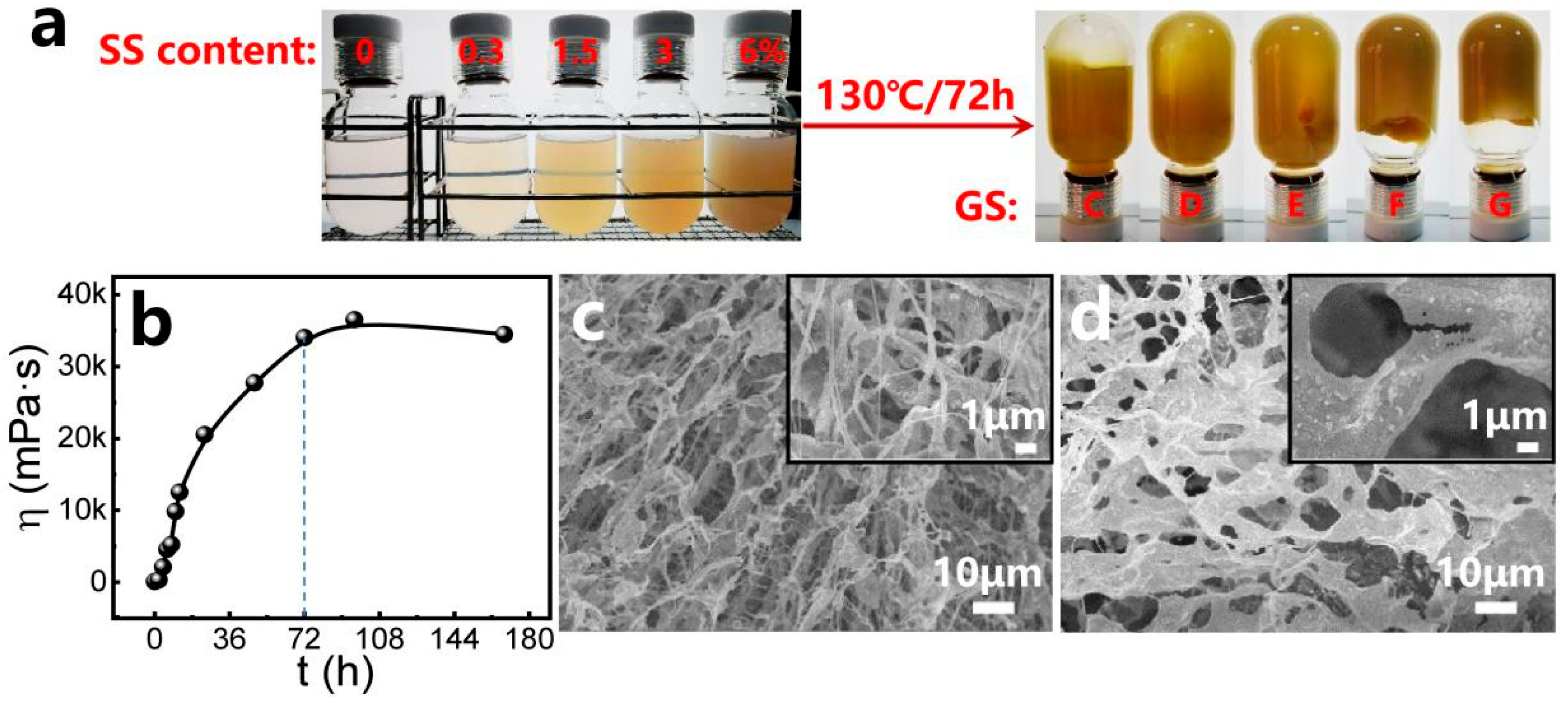
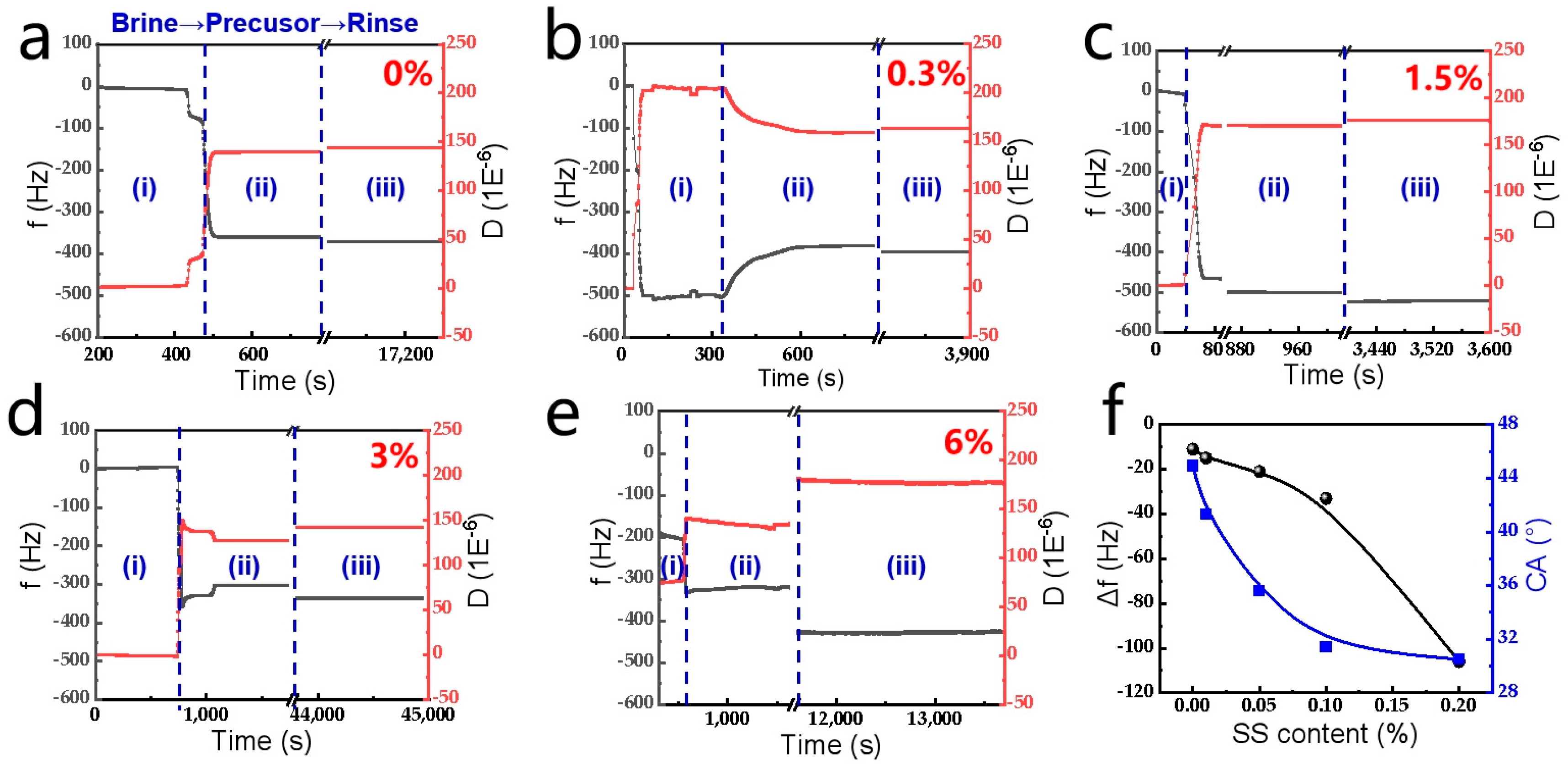
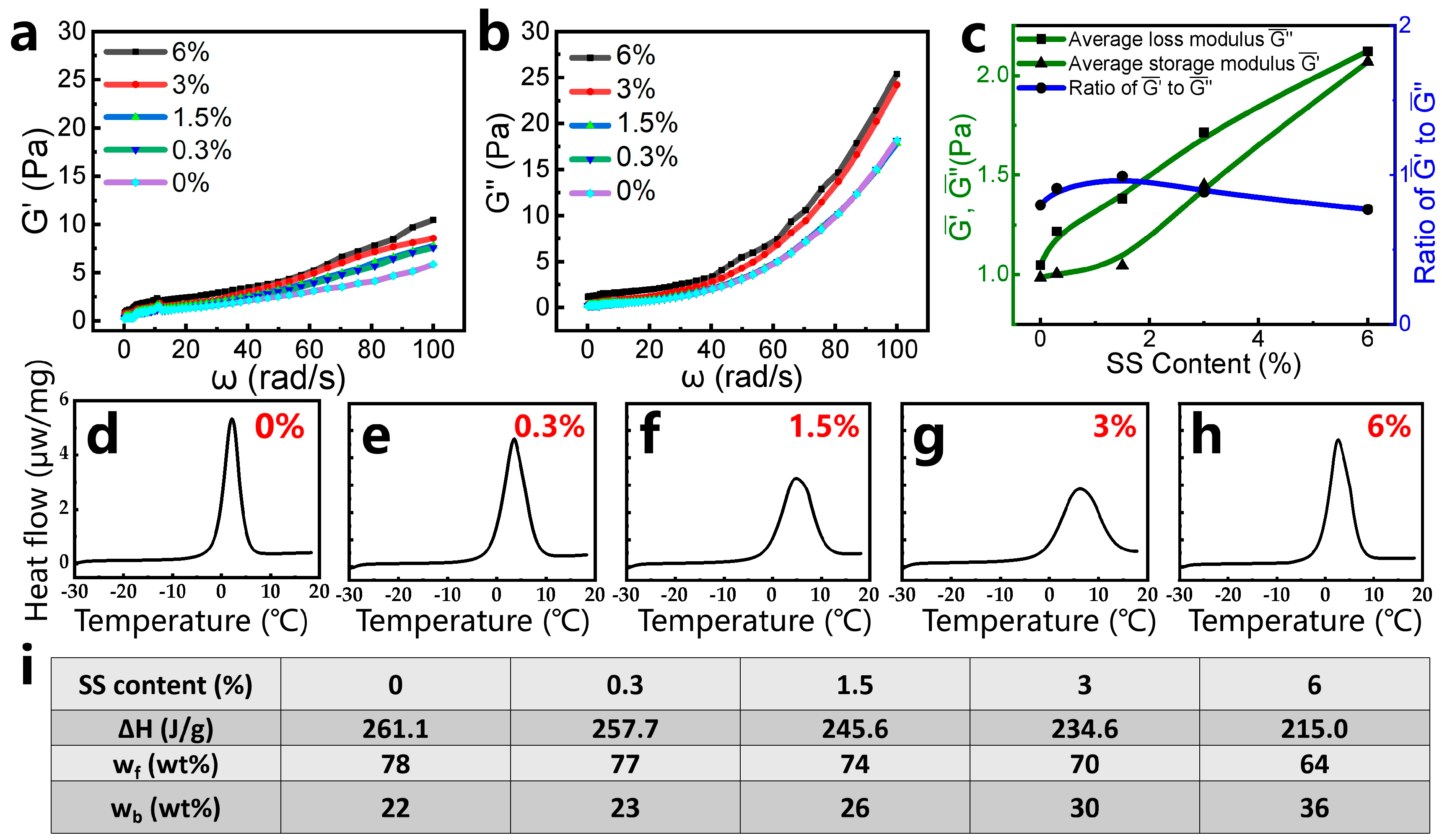
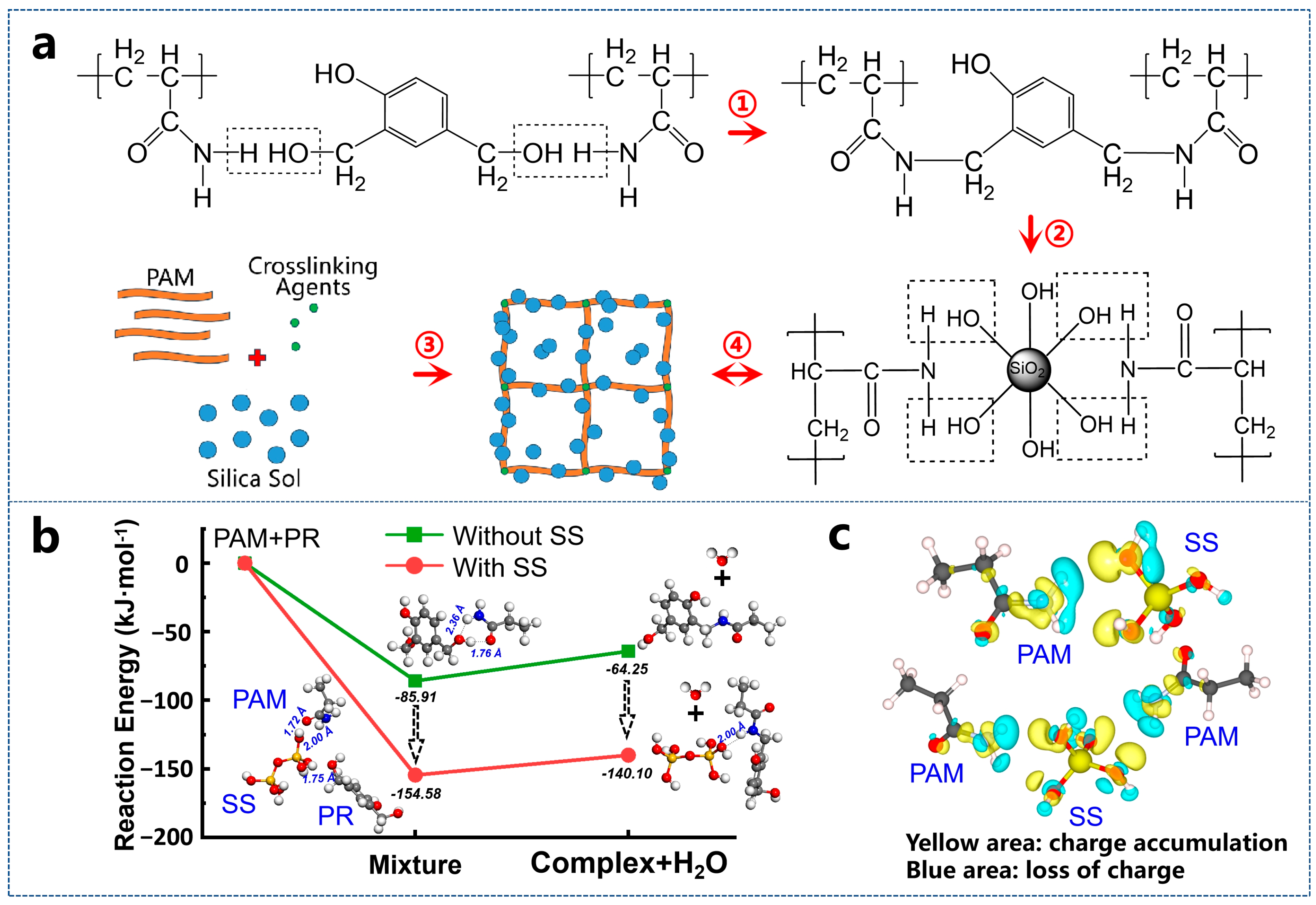
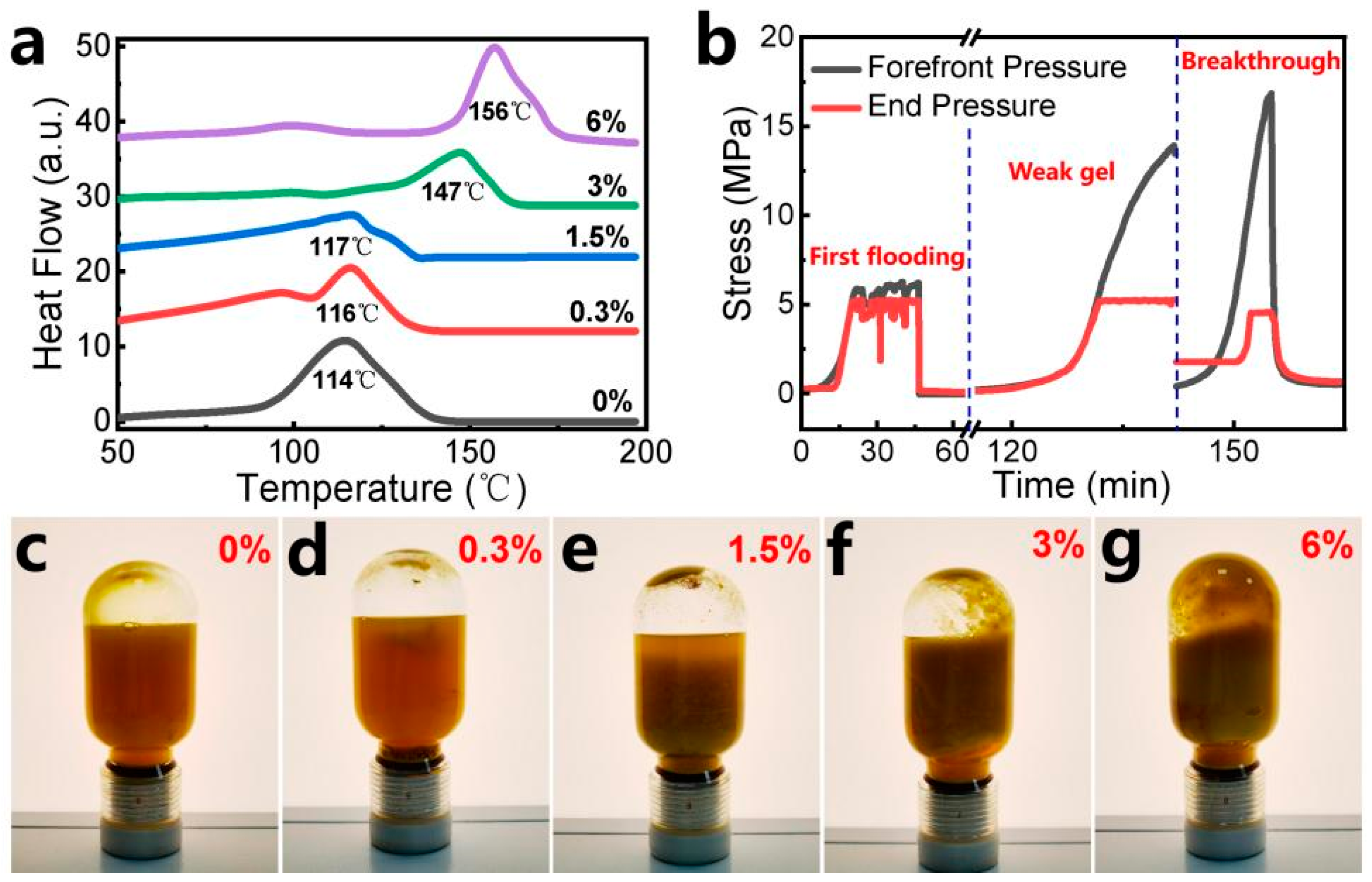
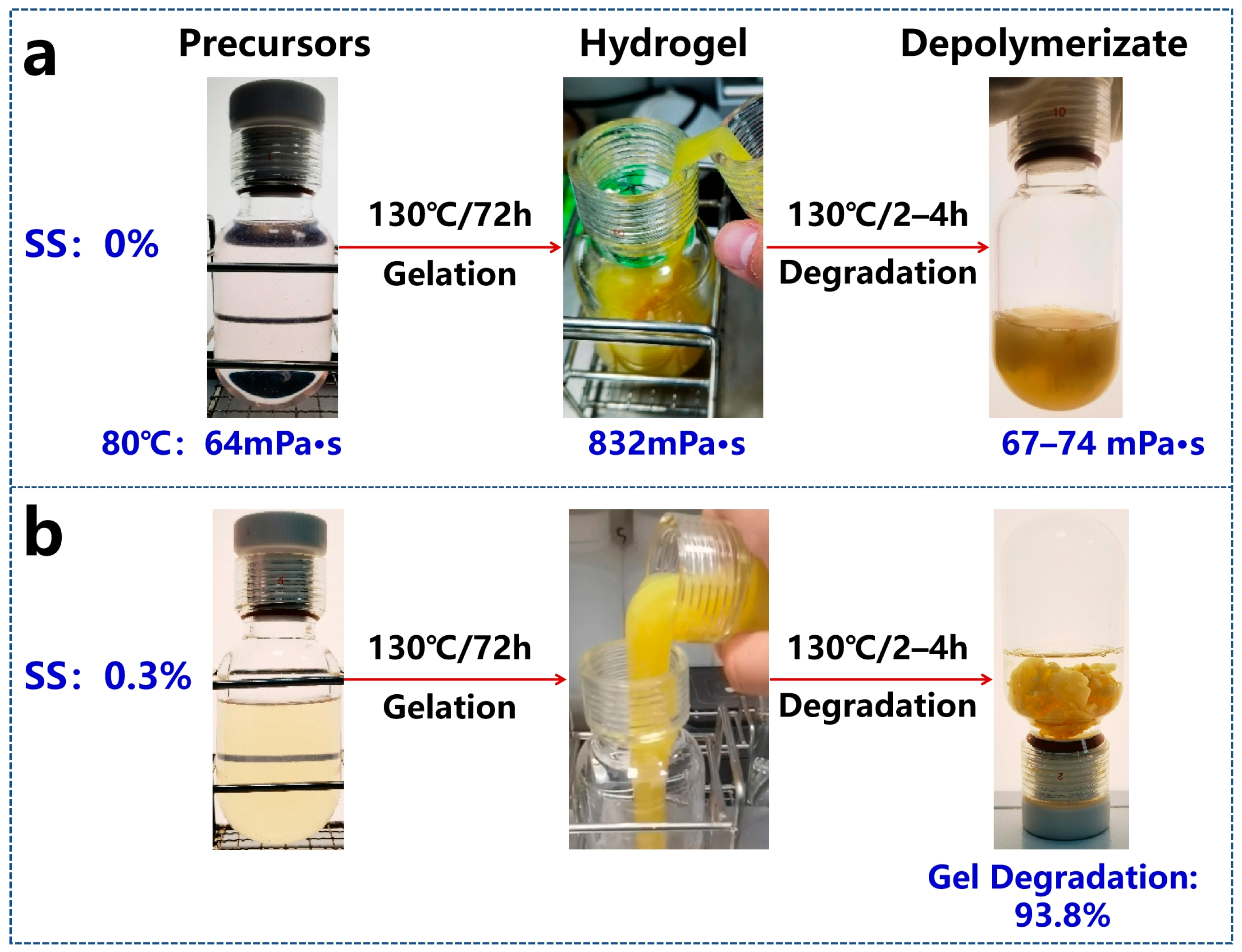
Disclaimer/Publisher’s Note: The statements, opinions and data contained in all publications are solely those of the individual author(s) and contributor(s) and not of MDPI and/or the editor(s). MDPI and/or the editor(s) disclaim responsibility for any injury to people or property resulting from any ideas, methods, instructions or products referred to in the content. |
© 2025 by the authors. Licensee MDPI, Basel, Switzerland. This article is an open access article distributed under the terms and conditions of the Creative Commons Attribution (CC BY) license (https://creativecommons.org/licenses/by/4.0/).
Share and Cite
Yang, H.; Zhang, J.; Wang, Z.; Li, S.; Wei, Q.; He, Y.; Li, L.; Zhao, J.; Xu, C.; Zhang, Z. In Situ-Prepared Nanocomposite for Water Management in High-Temperature Reservoirs. Gels 2025, 11, 405. https://doi.org/10.3390/gels11060405
Yang H, Zhang J, Wang Z, Li S, Wei Q, He Y, Li L, Zhao J, Xu C, Zhang Z. In Situ-Prepared Nanocomposite for Water Management in High-Temperature Reservoirs. Gels. 2025; 11(6):405. https://doi.org/10.3390/gels11060405
Chicago/Turabian StyleYang, Hui, Jian Zhang, Zhiwei Wang, Shichao Li, Qiang Wei, Yunteng He, Luyao Li, Jiachang Zhao, Caihong Xu, and Zongbo Zhang. 2025. "In Situ-Prepared Nanocomposite for Water Management in High-Temperature Reservoirs" Gels 11, no. 6: 405. https://doi.org/10.3390/gels11060405
APA StyleYang, H., Zhang, J., Wang, Z., Li, S., Wei, Q., He, Y., Li, L., Zhao, J., Xu, C., & Zhang, Z. (2025). In Situ-Prepared Nanocomposite for Water Management in High-Temperature Reservoirs. Gels, 11(6), 405. https://doi.org/10.3390/gels11060405





